Analysis of Patient Safety and Medical Errors in Healthcare
VerifiedAdded on 2022/09/22
|7
|1611
|22
Essay
AI Summary
This assignment delves into the critical topic of patient safety and medical errors within the healthcare system. It begins by emphasizing the importance of patient safety and the goal of providing quality care, while acknowledging the prevalence of preventable medical errors that can lead to adverse outcomes, injuries, or even death. The assignment presents a case scenario involving a 97-year-old patient who died due to a medication error by a nurse, detailing the incident and the nurse's actions. It then explores the consequences of such errors for both the nurse and the patient, including emotional distress, potential financial implications, physical injuries, and loss of life. Furthermore, the assignment outlines various nursing actions and interventions designed to prevent future errors, such as medication safety systems and infection control measures. The author also provides a personal reflection on the incident, expressing sympathy for those involved and highlighting the importance of teamwork and adherence to best practices. The assignment concludes by reiterating the need for proactive measures to minimize medical errors and promote patient safety, emphasizing the importance of quality care and the prevention of harm.
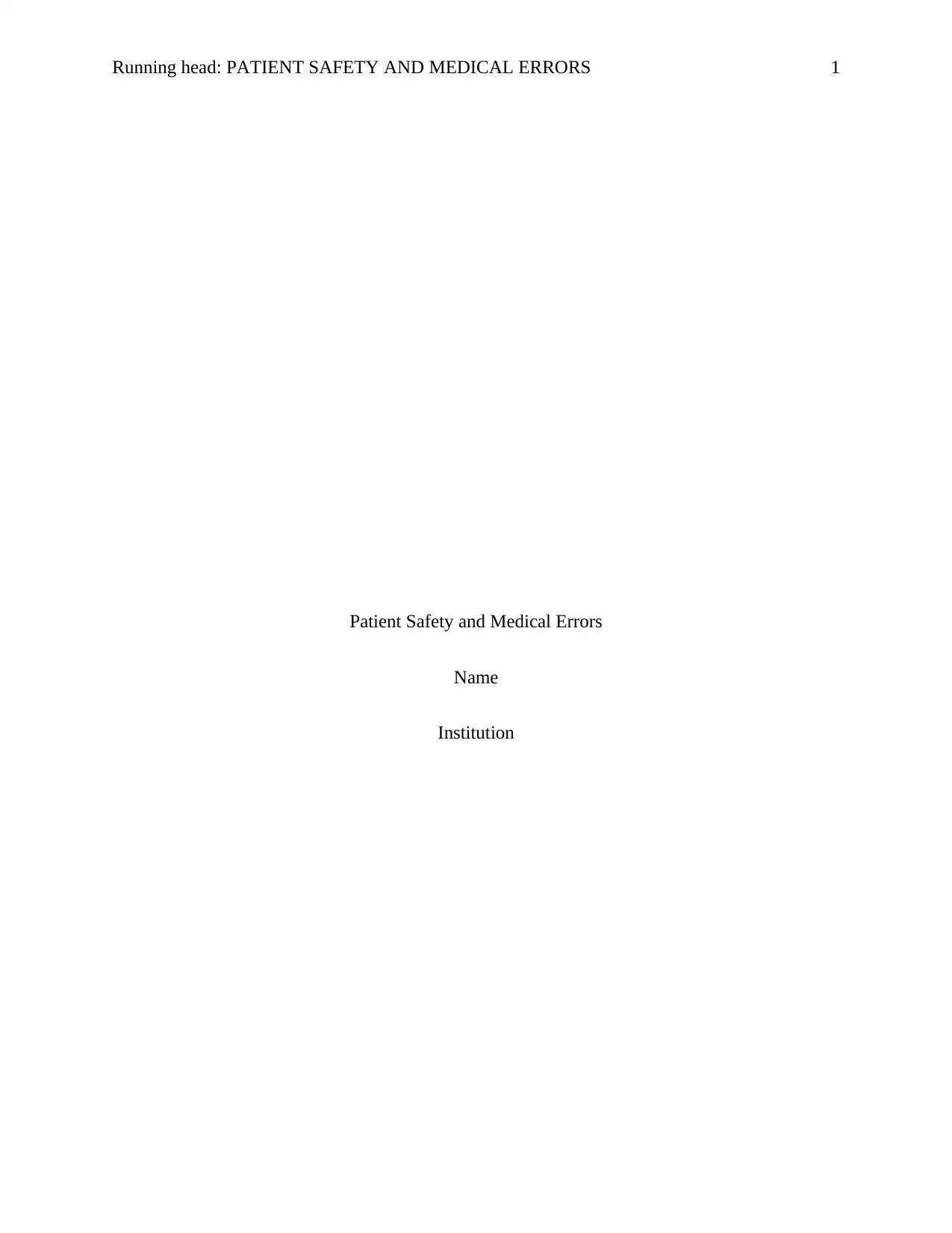
Running head: PATIENT SAFETY AND MEDICAL ERRORS 1
Patient Safety and Medical Errors
Name
Institution
Patient Safety and Medical Errors
Name
Institution
Paraphrase This Document
Need a fresh take? Get an instant paraphrase of this document with our AI Paraphraser
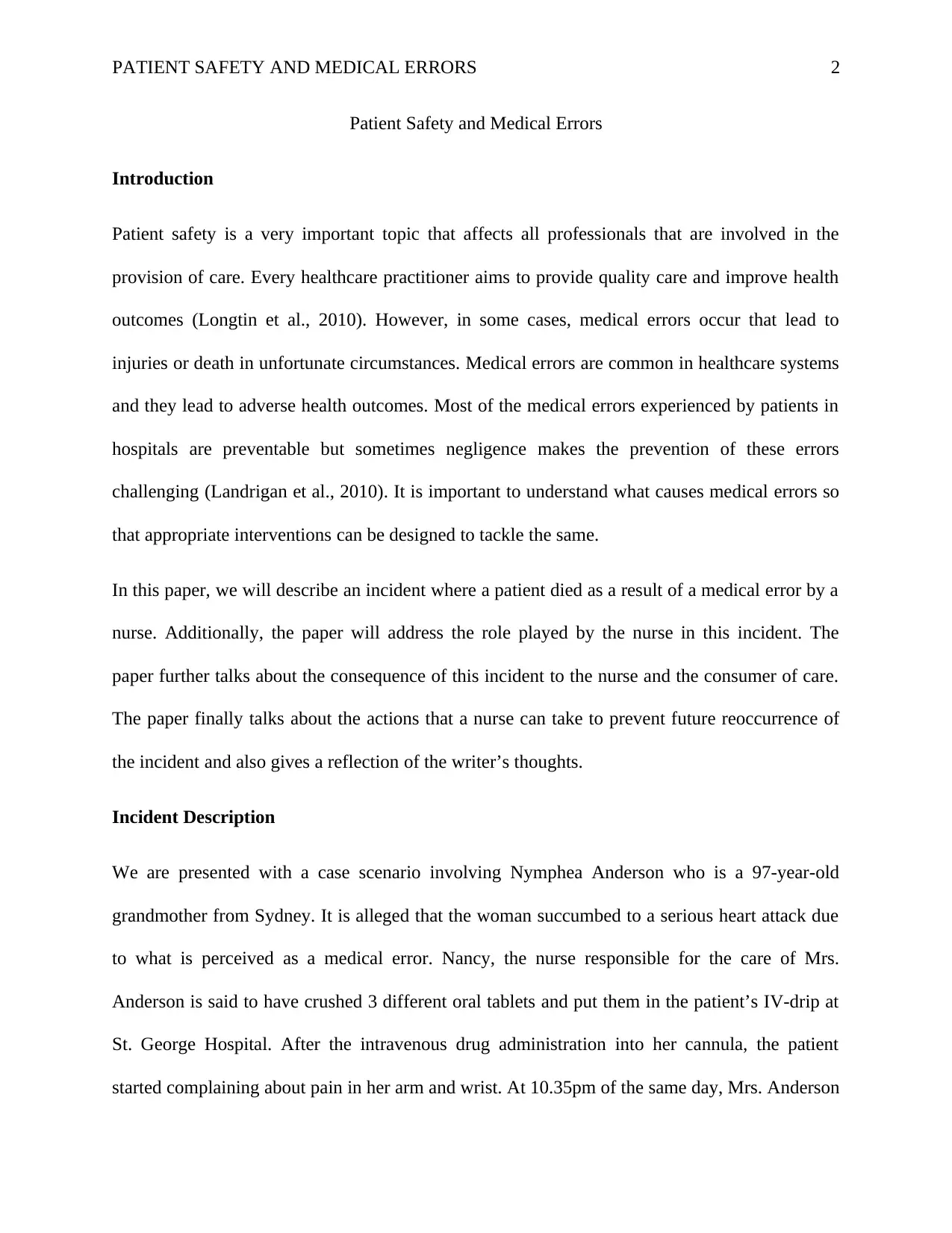
PATIENT SAFETY AND MEDICAL ERRORS 2
Patient Safety and Medical Errors
Introduction
Patient safety is a very important topic that affects all professionals that are involved in the
provision of care. Every healthcare practitioner aims to provide quality care and improve health
outcomes (Longtin et al., 2010). However, in some cases, medical errors occur that lead to
injuries or death in unfortunate circumstances. Medical errors are common in healthcare systems
and they lead to adverse health outcomes. Most of the medical errors experienced by patients in
hospitals are preventable but sometimes negligence makes the prevention of these errors
challenging (Landrigan et al., 2010). It is important to understand what causes medical errors so
that appropriate interventions can be designed to tackle the same.
In this paper, we will describe an incident where a patient died as a result of a medical error by a
nurse. Additionally, the paper will address the role played by the nurse in this incident. The
paper further talks about the consequence of this incident to the nurse and the consumer of care.
The paper finally talks about the actions that a nurse can take to prevent future reoccurrence of
the incident and also gives a reflection of the writer’s thoughts.
Incident Description
We are presented with a case scenario involving Nymphea Anderson who is a 97-year-old
grandmother from Sydney. It is alleged that the woman succumbed to a serious heart attack due
to what is perceived as a medical error. Nancy, the nurse responsible for the care of Mrs.
Anderson is said to have crushed 3 different oral tablets and put them in the patient’s IV-drip at
St. George Hospital. After the intravenous drug administration into her cannula, the patient
started complaining about pain in her arm and wrist. At 10.35pm of the same day, Mrs. Anderson
Patient Safety and Medical Errors
Introduction
Patient safety is a very important topic that affects all professionals that are involved in the
provision of care. Every healthcare practitioner aims to provide quality care and improve health
outcomes (Longtin et al., 2010). However, in some cases, medical errors occur that lead to
injuries or death in unfortunate circumstances. Medical errors are common in healthcare systems
and they lead to adverse health outcomes. Most of the medical errors experienced by patients in
hospitals are preventable but sometimes negligence makes the prevention of these errors
challenging (Landrigan et al., 2010). It is important to understand what causes medical errors so
that appropriate interventions can be designed to tackle the same.
In this paper, we will describe an incident where a patient died as a result of a medical error by a
nurse. Additionally, the paper will address the role played by the nurse in this incident. The
paper further talks about the consequence of this incident to the nurse and the consumer of care.
The paper finally talks about the actions that a nurse can take to prevent future reoccurrence of
the incident and also gives a reflection of the writer’s thoughts.
Incident Description
We are presented with a case scenario involving Nymphea Anderson who is a 97-year-old
grandmother from Sydney. It is alleged that the woman succumbed to a serious heart attack due
to what is perceived as a medical error. Nancy, the nurse responsible for the care of Mrs.
Anderson is said to have crushed 3 different oral tablets and put them in the patient’s IV-drip at
St. George Hospital. After the intravenous drug administration into her cannula, the patient
started complaining about pain in her arm and wrist. At 10.35pm of the same day, Mrs. Anderson
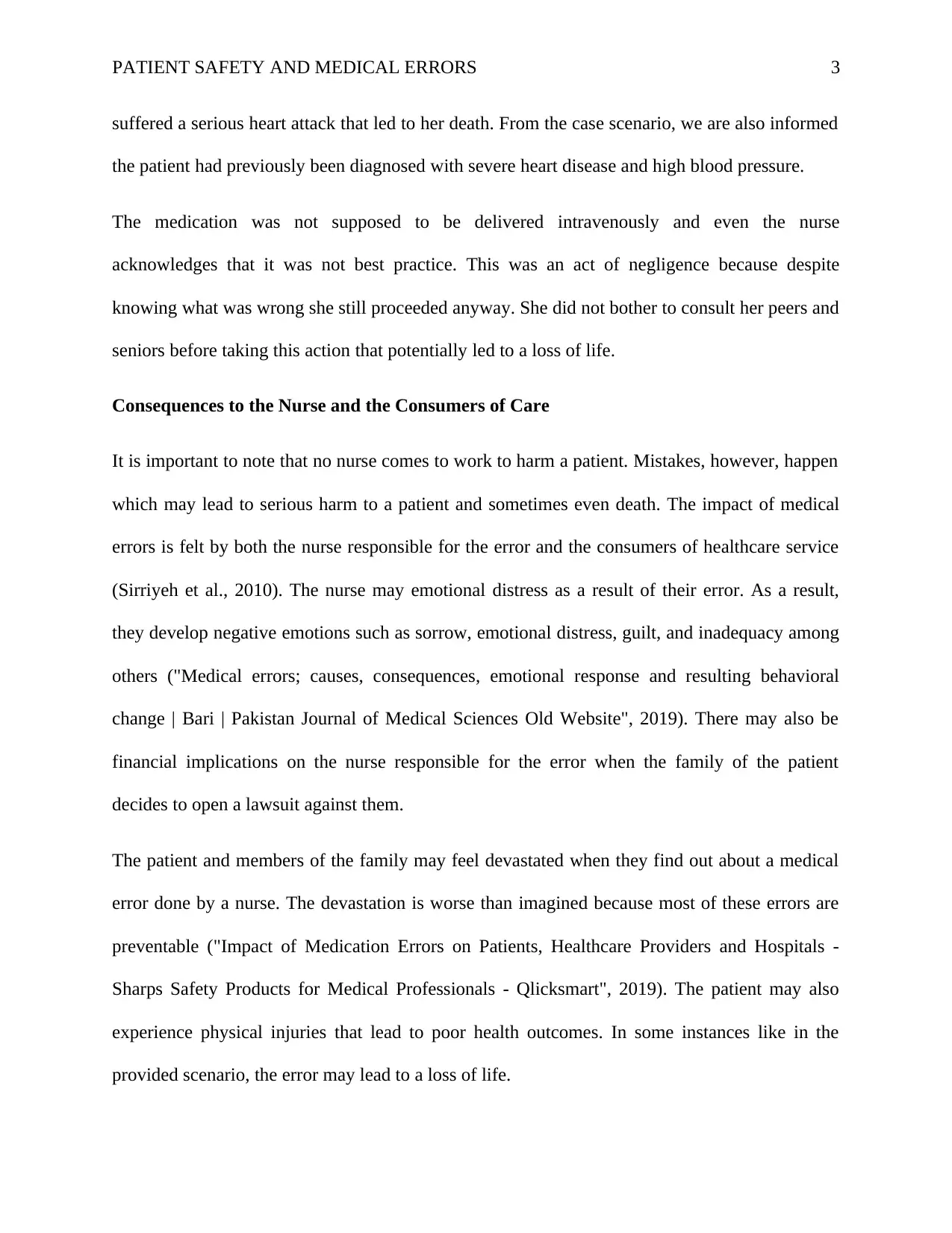
PATIENT SAFETY AND MEDICAL ERRORS 3
suffered a serious heart attack that led to her death. From the case scenario, we are also informed
the patient had previously been diagnosed with severe heart disease and high blood pressure.
The medication was not supposed to be delivered intravenously and even the nurse
acknowledges that it was not best practice. This was an act of negligence because despite
knowing what was wrong she still proceeded anyway. She did not bother to consult her peers and
seniors before taking this action that potentially led to a loss of life.
Consequences to the Nurse and the Consumers of Care
It is important to note that no nurse comes to work to harm a patient. Mistakes, however, happen
which may lead to serious harm to a patient and sometimes even death. The impact of medical
errors is felt by both the nurse responsible for the error and the consumers of healthcare service
(Sirriyeh et al., 2010). The nurse may emotional distress as a result of their error. As a result,
they develop negative emotions such as sorrow, emotional distress, guilt, and inadequacy among
others ("Medical errors; causes, consequences, emotional response and resulting behavioral
change | Bari | Pakistan Journal of Medical Sciences Old Website", 2019). There may also be
financial implications on the nurse responsible for the error when the family of the patient
decides to open a lawsuit against them.
The patient and members of the family may feel devastated when they find out about a medical
error done by a nurse. The devastation is worse than imagined because most of these errors are
preventable ("Impact of Medication Errors on Patients, Healthcare Providers and Hospitals -
Sharps Safety Products for Medical Professionals - Qlicksmart", 2019). The patient may also
experience physical injuries that lead to poor health outcomes. In some instances like in the
provided scenario, the error may lead to a loss of life.
suffered a serious heart attack that led to her death. From the case scenario, we are also informed
the patient had previously been diagnosed with severe heart disease and high blood pressure.
The medication was not supposed to be delivered intravenously and even the nurse
acknowledges that it was not best practice. This was an act of negligence because despite
knowing what was wrong she still proceeded anyway. She did not bother to consult her peers and
seniors before taking this action that potentially led to a loss of life.
Consequences to the Nurse and the Consumers of Care
It is important to note that no nurse comes to work to harm a patient. Mistakes, however, happen
which may lead to serious harm to a patient and sometimes even death. The impact of medical
errors is felt by both the nurse responsible for the error and the consumers of healthcare service
(Sirriyeh et al., 2010). The nurse may emotional distress as a result of their error. As a result,
they develop negative emotions such as sorrow, emotional distress, guilt, and inadequacy among
others ("Medical errors; causes, consequences, emotional response and resulting behavioral
change | Bari | Pakistan Journal of Medical Sciences Old Website", 2019). There may also be
financial implications on the nurse responsible for the error when the family of the patient
decides to open a lawsuit against them.
The patient and members of the family may feel devastated when they find out about a medical
error done by a nurse. The devastation is worse than imagined because most of these errors are
preventable ("Impact of Medication Errors on Patients, Healthcare Providers and Hospitals -
Sharps Safety Products for Medical Professionals - Qlicksmart", 2019). The patient may also
experience physical injuries that lead to poor health outcomes. In some instances like in the
provided scenario, the error may lead to a loss of life.
⊘ This is a preview!⊘
Do you want full access?
Subscribe today to unlock all pages.

Trusted by 1+ million students worldwide
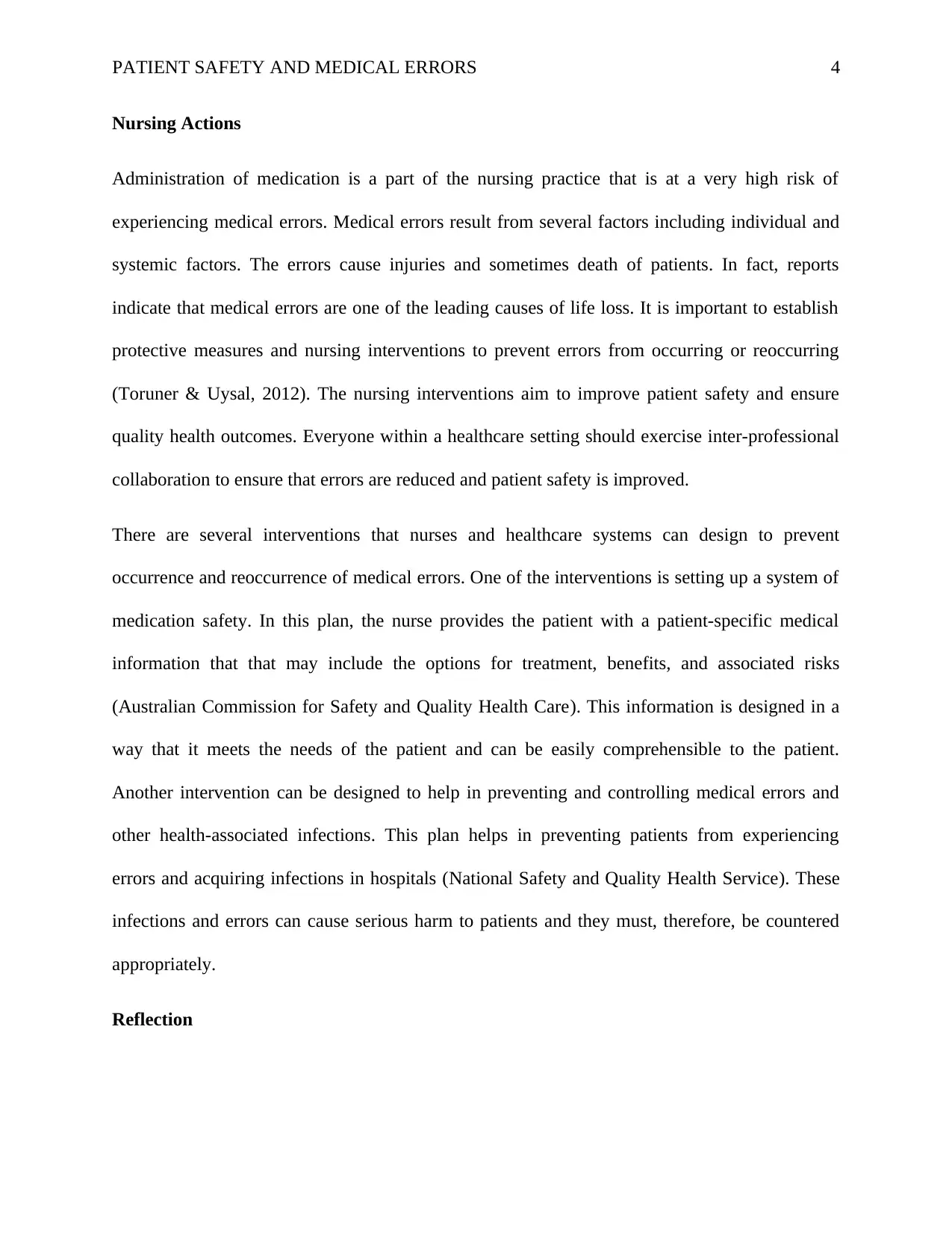
PATIENT SAFETY AND MEDICAL ERRORS 4
Nursing Actions
Administration of medication is a part of the nursing practice that is at a very high risk of
experiencing medical errors. Medical errors result from several factors including individual and
systemic factors. The errors cause injuries and sometimes death of patients. In fact, reports
indicate that medical errors are one of the leading causes of life loss. It is important to establish
protective measures and nursing interventions to prevent errors from occurring or reoccurring
(Toruner & Uysal, 2012). The nursing interventions aim to improve patient safety and ensure
quality health outcomes. Everyone within a healthcare setting should exercise inter-professional
collaboration to ensure that errors are reduced and patient safety is improved.
There are several interventions that nurses and healthcare systems can design to prevent
occurrence and reoccurrence of medical errors. One of the interventions is setting up a system of
medication safety. In this plan, the nurse provides the patient with a patient-specific medical
information that that may include the options for treatment, benefits, and associated risks
(Australian Commission for Safety and Quality Health Care). This information is designed in a
way that it meets the needs of the patient and can be easily comprehensible to the patient.
Another intervention can be designed to help in preventing and controlling medical errors and
other health-associated infections. This plan helps in preventing patients from experiencing
errors and acquiring infections in hospitals (National Safety and Quality Health Service). These
infections and errors can cause serious harm to patients and they must, therefore, be countered
appropriately.
Reflection
Nursing Actions
Administration of medication is a part of the nursing practice that is at a very high risk of
experiencing medical errors. Medical errors result from several factors including individual and
systemic factors. The errors cause injuries and sometimes death of patients. In fact, reports
indicate that medical errors are one of the leading causes of life loss. It is important to establish
protective measures and nursing interventions to prevent errors from occurring or reoccurring
(Toruner & Uysal, 2012). The nursing interventions aim to improve patient safety and ensure
quality health outcomes. Everyone within a healthcare setting should exercise inter-professional
collaboration to ensure that errors are reduced and patient safety is improved.
There are several interventions that nurses and healthcare systems can design to prevent
occurrence and reoccurrence of medical errors. One of the interventions is setting up a system of
medication safety. In this plan, the nurse provides the patient with a patient-specific medical
information that that may include the options for treatment, benefits, and associated risks
(Australian Commission for Safety and Quality Health Care). This information is designed in a
way that it meets the needs of the patient and can be easily comprehensible to the patient.
Another intervention can be designed to help in preventing and controlling medical errors and
other health-associated infections. This plan helps in preventing patients from experiencing
errors and acquiring infections in hospitals (National Safety and Quality Health Service). These
infections and errors can cause serious harm to patients and they must, therefore, be countered
appropriately.
Reflection
Paraphrase This Document
Need a fresh take? Get an instant paraphrase of this document with our AI Paraphraser
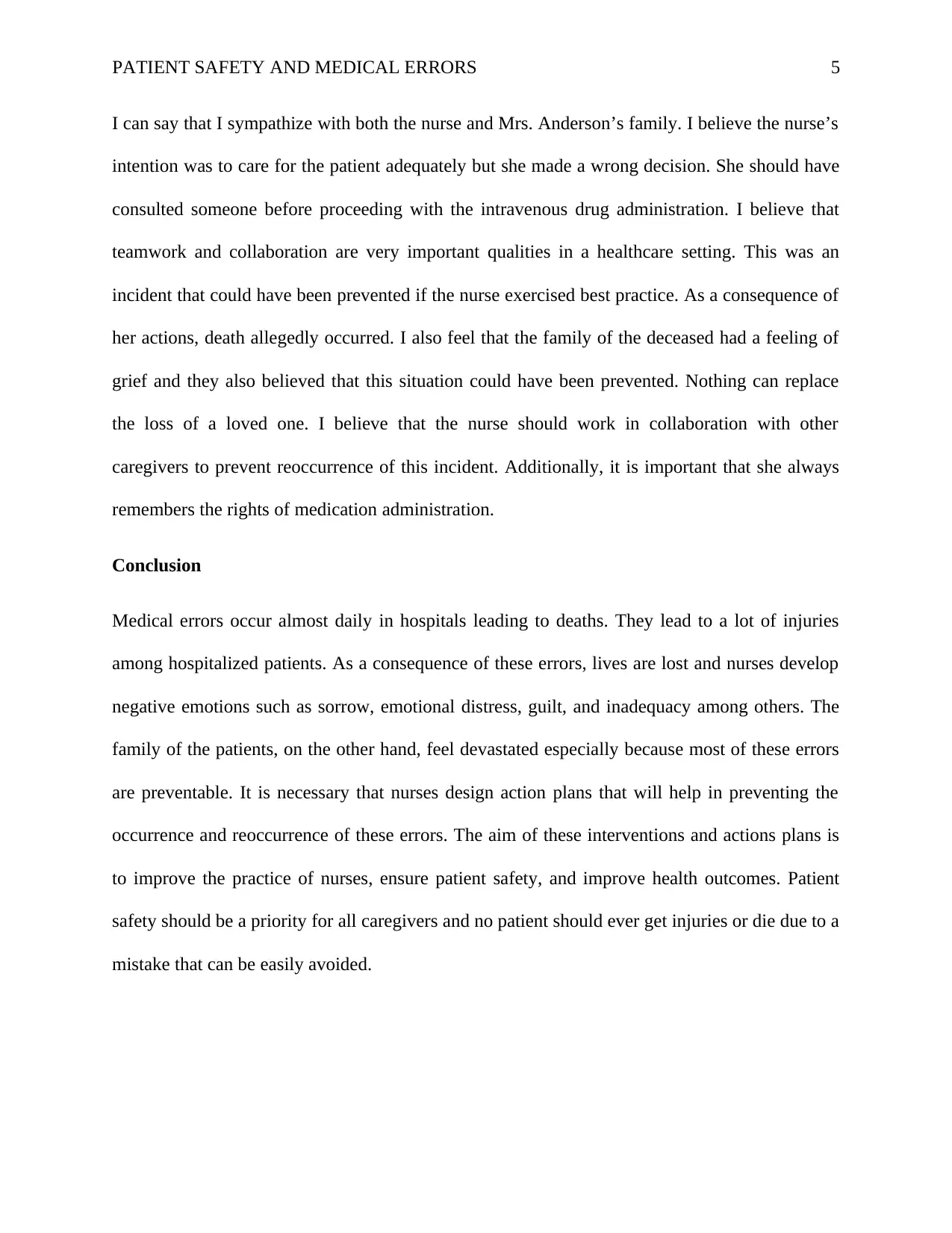
PATIENT SAFETY AND MEDICAL ERRORS 5
I can say that I sympathize with both the nurse and Mrs. Anderson’s family. I believe the nurse’s
intention was to care for the patient adequately but she made a wrong decision. She should have
consulted someone before proceeding with the intravenous drug administration. I believe that
teamwork and collaboration are very important qualities in a healthcare setting. This was an
incident that could have been prevented if the nurse exercised best practice. As a consequence of
her actions, death allegedly occurred. I also feel that the family of the deceased had a feeling of
grief and they also believed that this situation could have been prevented. Nothing can replace
the loss of a loved one. I believe that the nurse should work in collaboration with other
caregivers to prevent reoccurrence of this incident. Additionally, it is important that she always
remembers the rights of medication administration.
Conclusion
Medical errors occur almost daily in hospitals leading to deaths. They lead to a lot of injuries
among hospitalized patients. As a consequence of these errors, lives are lost and nurses develop
negative emotions such as sorrow, emotional distress, guilt, and inadequacy among others. The
family of the patients, on the other hand, feel devastated especially because most of these errors
are preventable. It is necessary that nurses design action plans that will help in preventing the
occurrence and reoccurrence of these errors. The aim of these interventions and actions plans is
to improve the practice of nurses, ensure patient safety, and improve health outcomes. Patient
safety should be a priority for all caregivers and no patient should ever get injuries or die due to a
mistake that can be easily avoided.
I can say that I sympathize with both the nurse and Mrs. Anderson’s family. I believe the nurse’s
intention was to care for the patient adequately but she made a wrong decision. She should have
consulted someone before proceeding with the intravenous drug administration. I believe that
teamwork and collaboration are very important qualities in a healthcare setting. This was an
incident that could have been prevented if the nurse exercised best practice. As a consequence of
her actions, death allegedly occurred. I also feel that the family of the deceased had a feeling of
grief and they also believed that this situation could have been prevented. Nothing can replace
the loss of a loved one. I believe that the nurse should work in collaboration with other
caregivers to prevent reoccurrence of this incident. Additionally, it is important that she always
remembers the rights of medication administration.
Conclusion
Medical errors occur almost daily in hospitals leading to deaths. They lead to a lot of injuries
among hospitalized patients. As a consequence of these errors, lives are lost and nurses develop
negative emotions such as sorrow, emotional distress, guilt, and inadequacy among others. The
family of the patients, on the other hand, feel devastated especially because most of these errors
are preventable. It is necessary that nurses design action plans that will help in preventing the
occurrence and reoccurrence of these errors. The aim of these interventions and actions plans is
to improve the practice of nurses, ensure patient safety, and improve health outcomes. Patient
safety should be a priority for all caregivers and no patient should ever get injuries or die due to a
mistake that can be easily avoided.
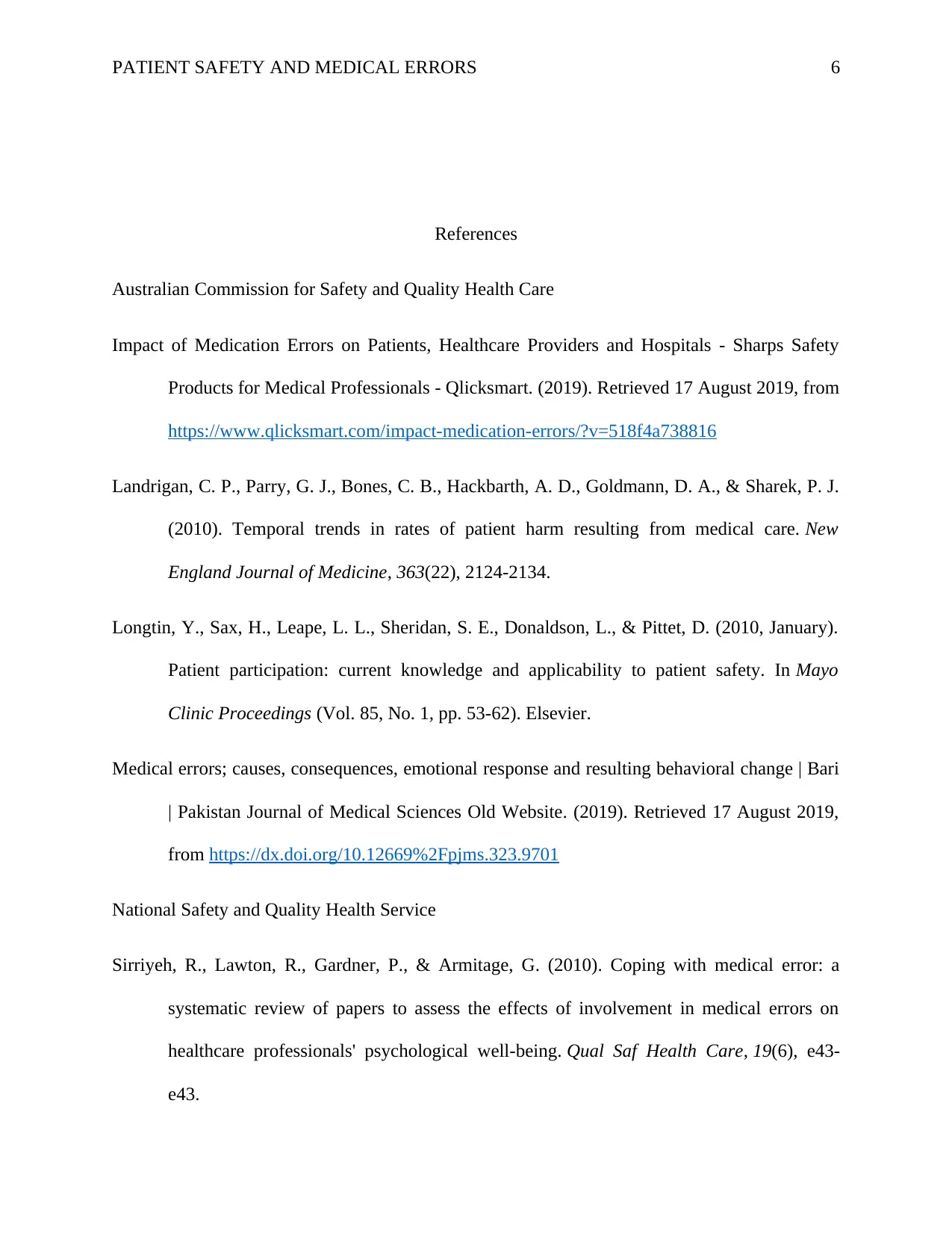
PATIENT SAFETY AND MEDICAL ERRORS 6
References
Australian Commission for Safety and Quality Health Care
Impact of Medication Errors on Patients, Healthcare Providers and Hospitals - Sharps Safety
Products for Medical Professionals - Qlicksmart. (2019). Retrieved 17 August 2019, from
https://www.qlicksmart.com/impact-medication-errors/?v=518f4a738816
Landrigan, C. P., Parry, G. J., Bones, C. B., Hackbarth, A. D., Goldmann, D. A., & Sharek, P. J.
(2010). Temporal trends in rates of patient harm resulting from medical care. New
England Journal of Medicine, 363(22), 2124-2134.
Longtin, Y., Sax, H., Leape, L. L., Sheridan, S. E., Donaldson, L., & Pittet, D. (2010, January).
Patient participation: current knowledge and applicability to patient safety. In Mayo
Clinic Proceedings (Vol. 85, No. 1, pp. 53-62). Elsevier.
Medical errors; causes, consequences, emotional response and resulting behavioral change | Bari
| Pakistan Journal of Medical Sciences Old Website. (2019). Retrieved 17 August 2019,
from https://dx.doi.org/10.12669%2Fpjms.323.9701
National Safety and Quality Health Service
Sirriyeh, R., Lawton, R., Gardner, P., & Armitage, G. (2010). Coping with medical error: a
systematic review of papers to assess the effects of involvement in medical errors on
healthcare professionals' psychological well-being. Qual Saf Health Care, 19(6), e43-
e43.
References
Australian Commission for Safety and Quality Health Care
Impact of Medication Errors on Patients, Healthcare Providers and Hospitals - Sharps Safety
Products for Medical Professionals - Qlicksmart. (2019). Retrieved 17 August 2019, from
https://www.qlicksmart.com/impact-medication-errors/?v=518f4a738816
Landrigan, C. P., Parry, G. J., Bones, C. B., Hackbarth, A. D., Goldmann, D. A., & Sharek, P. J.
(2010). Temporal trends in rates of patient harm resulting from medical care. New
England Journal of Medicine, 363(22), 2124-2134.
Longtin, Y., Sax, H., Leape, L. L., Sheridan, S. E., Donaldson, L., & Pittet, D. (2010, January).
Patient participation: current knowledge and applicability to patient safety. In Mayo
Clinic Proceedings (Vol. 85, No. 1, pp. 53-62). Elsevier.
Medical errors; causes, consequences, emotional response and resulting behavioral change | Bari
| Pakistan Journal of Medical Sciences Old Website. (2019). Retrieved 17 August 2019,
from https://dx.doi.org/10.12669%2Fpjms.323.9701
National Safety and Quality Health Service
Sirriyeh, R., Lawton, R., Gardner, P., & Armitage, G. (2010). Coping with medical error: a
systematic review of papers to assess the effects of involvement in medical errors on
healthcare professionals' psychological well-being. Qual Saf Health Care, 19(6), e43-
e43.
⊘ This is a preview!⊘
Do you want full access?
Subscribe today to unlock all pages.

Trusted by 1+ million students worldwide
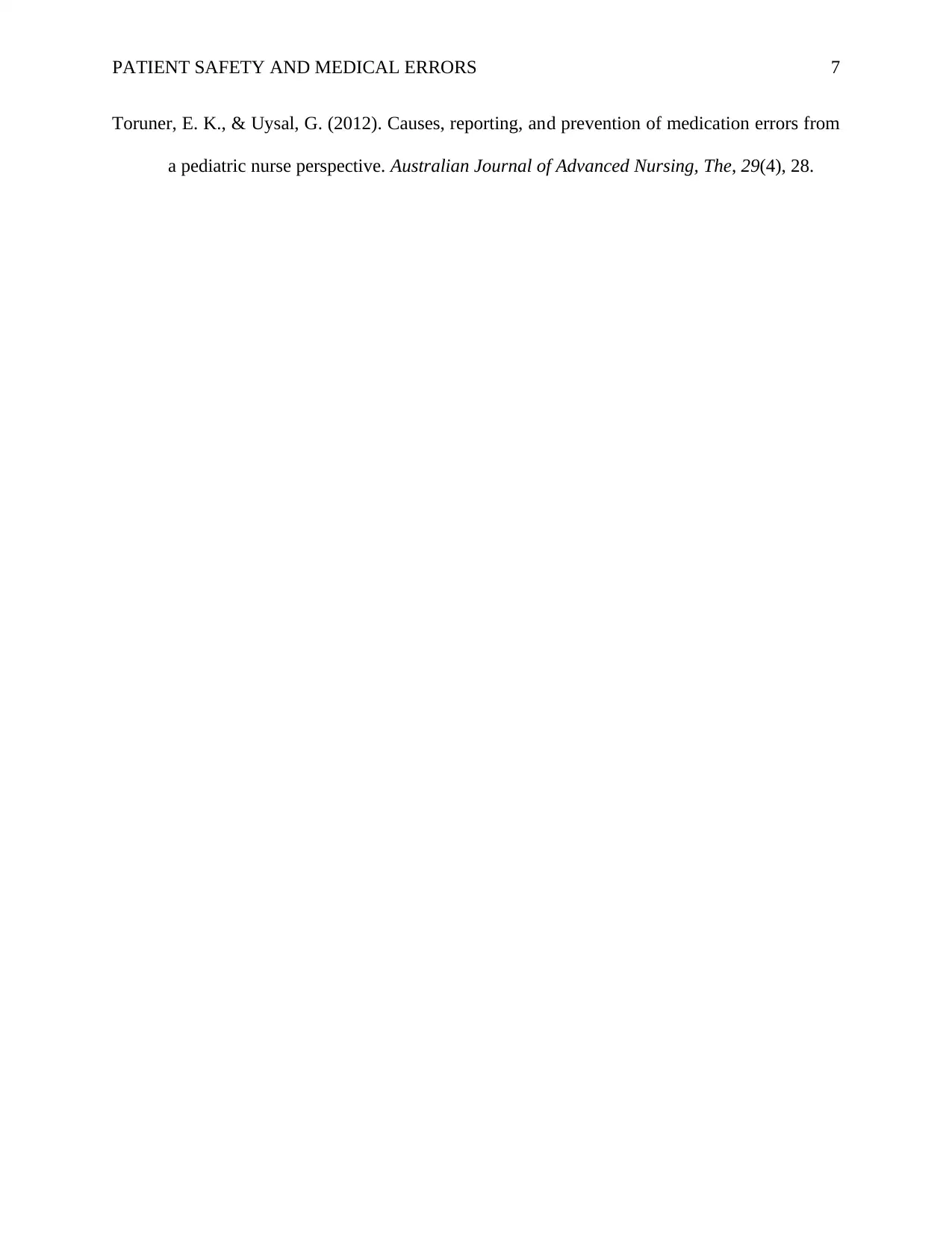
PATIENT SAFETY AND MEDICAL ERRORS 7
Toruner, E. K., & Uysal, G. (2012). Causes, reporting, and prevention of medication errors from
a pediatric nurse perspective. Australian Journal of Advanced Nursing, The, 29(4), 28.
Toruner, E. K., & Uysal, G. (2012). Causes, reporting, and prevention of medication errors from
a pediatric nurse perspective. Australian Journal of Advanced Nursing, The, 29(4), 28.
1 out of 7
Related Documents
Your All-in-One AI-Powered Toolkit for Academic Success.
+13062052269
info@desklib.com
Available 24*7 on WhatsApp / Email
![[object Object]](/_next/static/media/star-bottom.7253800d.svg)
Unlock your academic potential
Copyright © 2020–2025 A2Z Services. All Rights Reserved. Developed and managed by ZUCOL.





